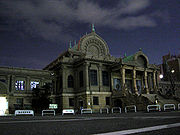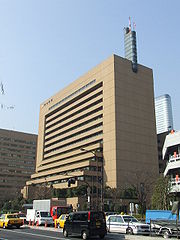
Tsukiji
Encyclopedia


Chuo, Tokyo
is one of the 23 special wards that form the heart of Tokyo, Japan. The ward refers to itself as Chūō City in English.Its Japanese name literally means "Central Ward," and it is historically the main commercial center of Tokyo, although Shinjuku has risen to challenge it since the end of World War II...
, Japan
Japan
Japan is an island nation in East Asia. Located in the Pacific Ocean, it lies to the east of the Sea of Japan, China, North Korea, South Korea and Russia, stretching from the Sea of Okhotsk in the north to the East China Sea and Taiwan in the south...
, the site of the Tsukiji fish market
Tsukiji fish market
The , commonly known as the , is the biggest wholesale fish and seafood market in the world and also one of the largest wholesale food markets of any kind. The market is located in Tsukiji in central Tokyo, and is a major attraction for foreign visitors....
. Literally meaning "reclaimed land
Land reclamation
Land reclamation, usually known as reclamation, is the process to create new land from sea or riverbeds. The land reclaimed is known as reclamation ground or landfill.- Habitation :...
," it lies near the Sumida River
Sumida River
The is a river which flows through Tokyo, Japan. It branches from the Arakawa River at Iwabuchi and flows into Tokyo Bay. Its tributaries include the Kanda and Shakujii rivers....
on land reclaimed from Tokyo Bay
Tokyo Bay
is a bay in the southern Kantō region of Japan. Its old name was .-Geography:Tokyo Bay is surrounded by the Bōsō Peninsula to the east and the Miura Peninsula to the west. In a narrow sense, Tokyo Bay is the area north of the straight line formed by the on the Miura Peninsula on one end and on...
in the 18th century, during the Edo period
Edo period
The , or , is a division of Japanese history which was ruled by the shoguns of the Tokugawa family, running from 1603 to 1868. The political entity of this period was the Tokugawa shogunate....
.
There are also districts named Tsukiji in Kobe and Amagasaki
Amagasaki, Hyogo
is an industrial city located in Hyōgo Prefecture, Japan. The city was founded on April 1, 1916. Its population is around 460,000, below its peak of over 554,000 in 1971.-History:...
, cities in Hyōgo Prefecture
Hyogo Prefecture
is a prefecture of Japan located in the Kansai region on Honshū island. The capital is Kobe.The prefecture's name was previously alternately spelled as Hiogo.- History :...
, although neither is as well known as Tokyo's.
History
Tsukiji is built on reclaimed land out of what were once lowland marshes along the Sumida River delta. Throughout the Tokugawa period, earth from the shogunate's extensive moat and canal excavations was systematically used to fill in the marshes along the river, creating new commercial districts and waterfront housing.The Great Meireki Fire of 1657 destroyed over two-thirds of Edo's buildings, including Hongan-ji
Tsukiji Hongan-ji
, sometimes archaically romanized Hongwan-ji, is a Jodo Shinshu Buddhist temple located in the Tsukiji district of Tokyo, Japan.Tsukiji Hongan-ji's predecessor was the temple of Edo-Asakusa Gobo , built in Asakusa in 1617 at the behest of the 12th monshu, Junnyo Shōnin.The temple burned during a...
temple in Asakusa, the enormous Kantō
Kanto region
The is a geographical area of Honshu, the largest island of Japan. The region includes the Greater Tokyo Area and encompasses seven prefectures: Gunma, Tochigi, Ibaraki, Saitama, Tokyo, Chiba, and Kanagawa. Within its boundaries, slightly more than 40 percent of the land area is the Kantō Plain....
headquarters of the Jōdo Shinshū
Jodo Shinshu
, also known as Shin Buddhism, is a school of Pure Land Buddhism. It was founded by the former Tendai Japanese monk Shinran. Today, Shin Buddhism is considered the most widely practiced branch of Buddhism in Japan.-Shinran :...
sect. As a result, the temple site was relocated to Tsukiji, where many of the residents of nearby Tsukudajima were instrumental in its reconstruction. A number of other temples were also erected on what is now the outer marketplace. In addition, many private residences for samurai and feudal lords were constructed along the southern edge of Tsukiji. In 1869, Tsukiji was designated as an approved residential area for foreigners.
The Great Kantō earthquake
1923 Great Kanto earthquake
The struck the Kantō plain on the Japanese main island of Honshū at 11:58:44 am JST on September 1, 1923. Varied accounts hold that the duration of the earthquake was between 4 and 10 minutes...
on September 1, 1923, and the resultant fires which raged in its aftermath, caused incalculable damage throughout central Tokyo. A significant portion of the Tsukiji district burned to the ground, and the old Nihonbashi
Nihonbashi
, or Nihombashi, is a business district of Chūō, Tokyo, Japan which grew up around the bridge of the same name which has linked two sides of the Nihonbashi River at this site since the 17th century. The first wooden bridge was completed in 1603, and the current bridge made of stone dates from 1911...
fish market was completely razed. In the citywide restructuring following the quake, the Nihonbashi fish market was relocated to the Tsukiji district, and after the construction of a modern market facility, reopened in 1935.
Places of interest
- For many tourists in Tokyo, the Central Wholesale Market, better known as the Tsukiji fish marketTsukiji fish marketThe , commonly known as the , is the biggest wholesale fish and seafood market in the world and also one of the largest wholesale food markets of any kind. The market is located in Tsukiji in central Tokyo, and is a major attraction for foreign visitors....
and said to be one of the best sushiSushiis a Japanese food consisting of cooked vinegared rice combined with other ingredients . Neta and forms of sushi presentation vary, but the ingredient which all sushi have in common is shari...
destinations in the world, is synonymous with Tsukiji. It is also the largest fish market in the world handling more than 2000 tons of 450 types of seafood daily. - Tsukiji Hongan-jiTsukiji Hongan-ji, sometimes archaically romanized Hongwan-ji, is a Jodo Shinshu Buddhist temple located in the Tsukiji district of Tokyo, Japan.Tsukiji Hongan-ji's predecessor was the temple of Edo-Asakusa Gobo , built in Asakusa in 1617 at the behest of the 12th monshu, Junnyo Shōnin.The temple burned during a...
, a key temple of the Jōdo ShinshūJodo Shinshu, also known as Shin Buddhism, is a school of Pure Land Buddhism. It was founded by the former Tendai Japanese monk Shinran. Today, Shin Buddhism is considered the most widely practiced branch of Buddhism in Japan.-Shinran :...
sect of BuddhismBuddhismBuddhism is a religion and philosophy encompassing a variety of traditions, beliefs and practices, largely based on teachings attributed to Siddhartha Gautama, commonly known as the Buddha . The Buddha lived and taught in the northeastern Indian subcontinent some time between the 6th and 4th...
. - Inside the temple is a small memorial to former J-rock star Hide.
- St. Luke's Garden Tower, one of Tokyo's tallest buildings, and the adjoining St. Luke's International HospitalSt. Luke's International Hospitalis a general hospital located in the Tsukiji district of Chūō, Tokyo, Japan. It was founded in 1902 by Rudolph Bolling Teusler, a missionary doctor sent by the American Episcopal Church. In 1933, R. B...
- National Cancer Center
Companies based in Tsukiji

- Asahi ShimbunAsahi ShimbunThe is the second most circulated out of the five national newspapers in Japan. Its circulation, which was 7.96 million for its morning edition and 3.1 million for its evening edition as of June 2010, was second behind that of Yomiuri Shimbun...
- Asatsu-DKAsatsu-DK, often abbreviated simply as ADK or sometime calls , is a Japanese advertising agency. Headquartered in Chūō, Tokyo, the firm is Japan's third largest advertising agency, after Dentsu and Hakuhodo. The agency has 38 offices in over 15 countries. One of the offices, Asatsu-DK Europe, was...
- Nihon Ad SystemsNihon Ad Systems, NAS for short, is a Japanese anime production and character merchandising company, a wholly owned subsidiary of the advertising agency Asatsu-DK. The "Ad" in its title is an abbreviation for "Animation Development". Along with animation studios Sunrise, Toei Animation and TMS Entertainment, it is...
- NTT DataNTT Datais a system integration and IT consulting company of Nippon Telegraph and Telephone Group.Nippon Telegraph and Telephone Public Corporation, a predecessor of NTT, started Data Communications business in 1967...
Subway stations
- Tsukijishijō StationTsukijishijo Stationis a subway station in Chūō, Tokyo. It serves the lower part of the Tsukiji district, including the enormous Tokyo Metropolitan Central Wholesale Market, the Tokyo headquarters of the Asahi Shinbun newspaper, and Japan's National Cancer Center....
on Toei Ōedo LineToei Oedo LineThe is a subway line in Tokyo, Japan operated by the Tokyo Metropolitan Bureau of Transportation . It commenced full operations on December 12, 2000; using the Japanese calendar this reads "12/12/12" as the year 2000 equals Heisei 12... - Tsukiji StationTsukiji Stationis a subway station in Tsukiji, Chūō, Tokyo, Japan. It is operated by Tokyo Metro on the Hibiya Line, and has the station code H-10.-Location:The station is located in the Tsukiji neighbourhood of Chūō, Tokyo. Only a few blocks south of the station lies Tsukiji fish market, the largest seafood...
on Tokyo Metro Hibiya LineTokyo Metro Hibiya LineThe is a metro line owned and operated by Tokyo Metro located in Tokyo, Japan. The line was named after the district of Hibiya, under which it passes.-Overview:The Hibiya Line runs between in Meguro and in Adachi... - Shintomicho StationShintomicho StationShintomichō Station is the name of two train stations in Japan:*Shintomichō Station * Shintomichō Station...
on Tokyo Metro Yurakucho LineTokyo Metro Yurakucho LineThe is a subway line owned and operated by Tokyo Metro. The line connects Wakōshi Station in Wakō, Saitama and Shin-Kiba Station in Kōtō, Tokyo. On maps, diagrams and signboards, the line is shown using the color "gold" , and its stations are given numbers using the letter Y.The proper name as... - Walking distance from ShinbashiShinbashiis a district of Minato, Tokyo, Japan, located south of Ginza, west of Tsukiji, east of Toranomon and north of Hamamatsucho.-History:Shinbashi was the Tokyo terminus of the first railway in Japan in 1872...
and GinzaGinzais a district of Chūō, Tokyo, located south of Yaesu and Kyōbashi, west of Tsukiji, east of Yūrakuchō and Uchisaiwaichō, and north of Shinbashi.It is known as an upscale area of Tokyo with numerous department stores, boutiques, restaurants and coffeehouses. Ginza is recognized as one of the most...

